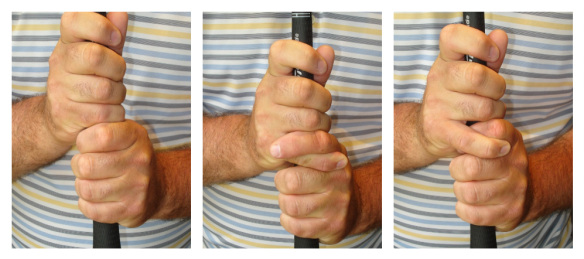Get a Grip
There they are above. You’ve got the less conventional baseball or ten finger on the left, and your lets say more conventional interlocking or overlapping (or Vardon if you like). That’s your basic choices. A very large percentage of tour Pro’s are going to be conventional. Very few have been, or are, ten fingered. Bob Rosburg, Moe Norman, and others have used the 10 finger grip. Bob Estes used it for a while but has since gone back to conventional. One current PGA tour player using a 10 finger is Scott Piercy. As regards conventional there are a few who use it unconventionally… Steve Jones used a reverse overlap, and Jim Furyk uses a double overlap. I am told the ladies tour sees a higher percentage of 10 fingered players, although could find no data to support that. (Leaving a “comment” that all players are 10 fingered in terms of a numerical digit count will only be funny once).
So just this month I have had a couple of players come to do some work with me… one a young teen, one mid twenties but on the verge of going pro… both baseballers… and both asking me my opinion on stick or bust with the 10 fingers. Not a problem other than the fact that I am not sure that I have an opinion. Typically the older guys coach had said stick with it, and the young lads coach had suggested it’s time to go conventional… and both could be good advice.
What are we told about the ten finger? Usually something like it lacks stability, control, cohesion, and prevents both hands from working together as a unit. So generally bad stuff. What has struck me personally about the ten finger? Well it’s typically described as a grip used by “weak people” but in my work I tend to see it being used by folks I would categorize as “strong people”. Strong grips, strong right hand technique… and as a sweeping generalization, folks who strength the ball out there rather than stroke it.
Of course that’s just my own working practice so what does data, research and study tell us about the grips and their apparent effectiveness. There is more stuff out there on grip materials than what is actually gripping the materials. Two of the more solid research articles I found were from Loughborough Uni and Colorado Uni… both were unconcerned about grip type but were very pleased with their discovery of force “signatures”.
“The existence of grip force ‘signatures’ was discovered, i.e. it was found that the forces produced by an individual golfer were very repeatable, but varied considerably between golfers”. Lough Uni, 2004
I could find limited data on injury incidence/prevalence and grip types. And had a look at my long drive hero’s on the Remax tour expecting to see a load of baseballers…. but didn’t. So I went back to some more anecdotal study and read a few of my more favoured internet voices to gauge their opinion. This one stuck out:
“My preference in instruction is the Vardon (also known as the overlapping) grip. I think it is the best way to unify the hands. However I do have pupils that have better success with the interlocking and full finger (you refer to it as a baseball) grips. If your hands are unified, square and control the club from twisting at impact, then I say use the grip you are using until you get too strong and feel one hand trying to dominate the other in the swing. Until that happens, as we say in Texas, “dance with the one who brung ya’.” Scott Robbins, US Teaching Pro
I love that Texan saying, and I think that is where I am going to sit with grips. Bottom line with my two guys is that they were both very good players, grip change or no grip change, and there was a lot of other stuff to be working on anyway, grip change or no change. I have a feeling that if you are going to work your way towards the elite end of golf then it is highly likely that your grip will migrate towards a conventional option just purely due to the overwhelming influence of common denomination. What you see, read and are told will tilt you in that direction. Are there any “rules” that can be loosely applied. Well may be:
- Should grip migration to conventional be “tried”… definitely. All variations can be tried, it doesn’t mean they have to be applied.
- Should grip migration to conventional be “recommended”… probably. Particularly in cases where the perceived ten finger characteristics are dominating technical development, or shot selection/adaptability. But it’s not a given!
- Should grip migration to conventional be “enforced”… never. Not at all. This is a “catch all” that will be counter-productive for a minority and is avoidable.
Of course to close, we can’t deny that your only point of contact with the club has to be an influential one on your swing… and may be that’s the more important factor. Not the type of grip, but where in your hands do you grip, and how much pressure do you apply. In a Texan style, I’ll save that for the next dance.
Bob Wood, Physical Solutions


Comments are closed.